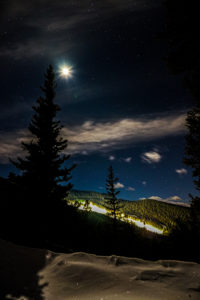There is no bad time for taking pictures of the night sky, but astrophotography during each moon cycle is a different experience.
New Moon
About 4 days before and after a new moon are the prime days to capture the milky way with the least amount of light pollution. You can see the crispness in the core and the foreground is dark. This is the ideal time to catch the blackest nights and the most amount of stars.


First Quarter, Last Quarter
During these times of the moon cycle, capturing the stars and the milky way are still possible; however, the foreground will appear almost as day. This is ok because you can darken in post processing, but it is hard to add light where there was none before. Always better to over expose than under. In most of my photos I prefer a little light to see the foreground but it’s a matter of preference. You will need to adjust your shutter speed, ISO, and aperture to get the right balance. Shutter speed will go down, ISO down, aperture up- and you will need to take a few shots to determine what the sweet spot is. Where you are facing in the sky will matter too if you are including the moon in the shot or not. The moon will also appear as full even if it’s only a crescent. If you are wanting crescent moon pictures, it is best to shoot in auto and use a lens that allows you to zoom in really far.


Full Moon
For about 5 days before and after a full moon there will be the most light pollution. This will make your skies appear more grey or even orange but you will still capture stars and a diluted version of the milky way. Again, this can be touched up in post processing to take away the brightness of the sky and foreground if so desired. Shots including the moon do best in the automatic setting if you are looking for detail in the moon.


Seasons
The Milky Way is visible the entire year however the core is only visible for a few months. The best time to see the Milky Way in North America is between April and October. This is when the core is visible- our galactic center. The winter months provide other gems though like the constellation Orion which is only visible in the winter sky. The winter also provides snow which really adds contrast to pictures making them pop. Meteor showers are also more prevalent in the winter months.
Time of Day
Check the moon cycle for when you are wanting to go out to shoot because the moon rises and sets at different times throughout the year. Sometimes you can get a few hours of complete darkness during a full moon if it rises early or late enough.
Clouds
The weather can certainly interfere with astrophotography. I don’t attempt to shoot stars on cloudy or mostly cloudy evenings, but I will go shoot on evenings forecasted to be partly cloudy. Sometimes clouds in an image can really add a whole different look making the stars look mysteriously hidden as they peek through the holes. It’s really a matter of preference. Storms can also be incredibly interesting to photograph but that’s a different blog.

Definitely don’t let the phase of the moon discourage you from booking an astrophotography experience during the dates that work for you. If you’d rather just experience the night skies in the Rockies, consider a stargazing photo shoot or a stargazing tour.
Night Photography and Moon Cycle FAQ
About 4 days before and after a new moon are the prime days to capture the milky way with the least amount of light pollution. You can see the crispness in the core and the foreground is dark. This is the ideal time to catch the blackest nights and the most amount of stars.
The Milky Way is visible the entire year however the core is only visible for a few months. The best time to see the Milky Way in North America is between April and October. This is when the core is visible- our galactic center. The winter months provide other gems though like the constellation Orion which is only visible in the winter sky. The winter also provides snow which really adds contrast to pictures making them pop. Meteor showers are also more prevalent in the winter months.
For about 5 days before and after a full moon there will be the most light pollution. This will make your skies appear more grey or even orange but you will still capture stars and a diluted version of the milky way. Again, this can be touched up in post processing to take away the brightness of the sky and foreground if so desired. Shots including the moon do best in the automatic setting if you are looking for detail in the moon.
